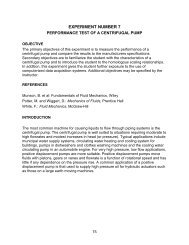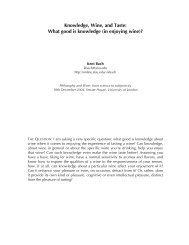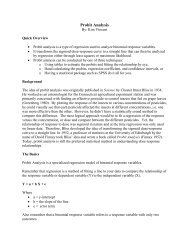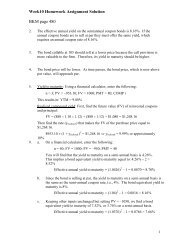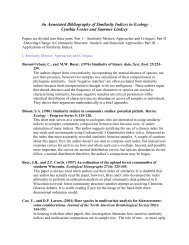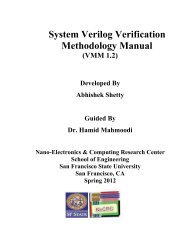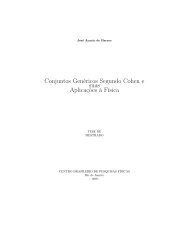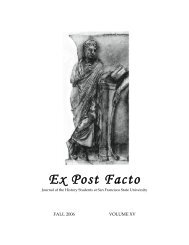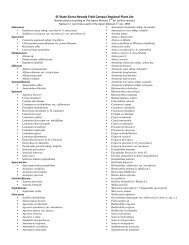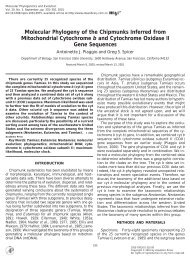The Historiography of Mexican Masculinity
The Historiography of Mexican Masculinity
The Historiography of Mexican Masculinity
You also want an ePaper? Increase the reach of your titles
YUMPU automatically turns print PDFs into web optimized ePapers that Google loves.
Reactionary Gender Studies?<br />
<strong>The</strong> <strong>Historiography</strong> <strong>of</strong> <strong>Mexican</strong> <strong>Masculinity</strong><br />
Galadriel Mehera Gerardo<br />
Since the so-called feminist revolution <strong>of</strong> the 1970s, scholarship on women has become<br />
fairly commonplace. Especially within the social sciences, scholars have increasingly<br />
examined women‟s lives in past and present times. Examining the previously ignored<br />
history <strong>of</strong> women has brought forth an entirely new way <strong>of</strong> looking at the past, closely<br />
tied with the “new social history” which has emerged in the United States in recent<br />
decades. However, the counterpart <strong>of</strong> women‟s studies, “men‟s studies,” as they relate to<br />
men as gendered entities, has failed to proliferate in the manner women‟s studies<br />
has. Only recently have scholars become interested in researching men and masculinity,<br />
and the scholarship has not flourished. Scholarship on masculinity has been especially<br />
sparse within studies <strong>of</strong> Latin America. <strong>The</strong> trend seems odd, especially given the<br />
common assumption in Western countries that Latin American men are<br />
“machos.” Recently, however, some scholars have attempted to permeate the uncharted<br />
area <strong>of</strong> study in countries like Mexico. Mexico proves especially interesting when<br />
examining masculinity given its strong association with the concept <strong>of</strong> “machismo” in the<br />
United States. Western scholars scrutinizing masculinity in Mexico, therefore, may have<br />
chosen the country as a seemingly quintessential representation <strong>of</strong> masculinity in all <strong>of</strong><br />
Latin America. However, the strongest scholarship on masculinity in Mexico recognizes<br />
what is specifically <strong>Mexican</strong> about the expression <strong>of</strong> masculinity discussed, even<br />
assessing the variance <strong>of</strong> “masculinities” within Mexico, based on differing regions,<br />
classes, ages, periods, and ethnicities. <strong>The</strong> historiography <strong>of</strong> masculinity in Mexico<br />
proves difficult to discuss because <strong>of</strong> the variation in <strong>Mexican</strong> culture, resulting in a<br />
variety <strong>of</strong> discussions <strong>of</strong> masculinity. Not only do the few scholars who have researched<br />
<strong>Mexican</strong> masculinity differ in the region and periods in which they examine <strong>Mexican</strong><br />
masculinity, but they also work in different areas <strong>of</strong> the social sciences, so they each<br />
approach the topic differently. Yet despite the differences in mode and method <strong>of</strong> study,<br />
the study <strong>of</strong> existing scholarship on <strong>Mexican</strong> masculinity proves valid because one can<br />
observe several trends, assumptions, and stereotypes in the scholarship which leave it<br />
lacking. While one must recognize the existing scholarship on <strong>Mexican</strong> masculinity<br />
proves revolutionary if only because it represents the first example <strong>of</strong> a new field <strong>of</strong><br />
study, one must also acknowledge and anatomize its faults in order to insure more valid<br />
conclusions on the subject in future studies. While the works on <strong>Mexican</strong> masculinity<br />
both differ and agree depending on the aspect <strong>of</strong> masculinity discussed, they all represent<br />
similar failings because <strong>of</strong> source problems, a tendency to base their arguments on<br />
stereotypical notions, and a failure to employ an interdisciplinary approach. Future<br />
scholarship on masculinity may learn from these shortcomings and embrace the merits <strong>of</strong><br />
the current scholarship, producing a better-rounded and realistic depiction <strong>of</strong> <strong>Mexican</strong><br />
men, both past and present.<br />
Background: Oscar Lewis and the Origin <strong>of</strong> the Term “Machismo”
Intrinsic to all studies <strong>of</strong> <strong>Mexican</strong> masculinity is the term “machismo,” a word<br />
used as the stereotype <strong>of</strong> <strong>Mexican</strong> men, portraying them as estranged from their wives<br />
and children, prone towards violence for no particular reason, and forcing the complete<br />
subjugation <strong>of</strong> women to men. [1] <strong>The</strong> origin <strong>of</strong> the term machismo remains unclear.<br />
Matthew Gutmann, an anthropologist who studied masculinity in a working class<br />
community in Mexico City, expresses the belief machismo is a new concept that emerged<br />
in the 1940s and is tied to <strong>Mexican</strong> cinema. [2] Although Gutmann shies away from<br />
completely attributing the emergence <strong>of</strong> machismo to cinema alone, he insists the concept<br />
emerged recently, yet he does not examine the source <strong>of</strong> the word itself, nor whether the<br />
stereotype associated with it actually emerged for the first time in the 1940s. <strong>The</strong> term is<br />
obviously tied to the much older word “macho,” which does not carry the negative<br />
connotations attached to machismo, [3] and in Mexico is used as a synonym for "boy" or<br />
"man." In her study <strong>of</strong> the phenomena <strong>of</strong> “marianismo,” the female counterpart to<br />
machismo, Evelyn Stevens examines the roots <strong>of</strong> marianismo, tracing them back as far as<br />
the early Mesopotamian cultures. [4] However, Stevens examines the traits associated<br />
with the concept <strong>of</strong> marianismo (a word invented by scholars to catalog the stereotype <strong>of</strong><br />
Latin American women which juxtaposes them against Latin American men), not<br />
the derivatives <strong>of</strong> the word itself.<br />
Despite the creation <strong>of</strong> the word marianismo by scholars, few have questioned the<br />
origin <strong>of</strong> the word machismo and its accuracy in describing <strong>Mexican</strong> men. <strong>The</strong> Oxford<br />
English dictionary supports Gutmann‟s statement that the word machismo indeed<br />
emerged in the mid-twentieth century, claiming the word originated in the United States<br />
in the 1940s, deriving from the Spanish word macho. [5] Of five Spanish dictionaries<br />
examined, [6] only one contains the word machismo, and it is a dictionary published in the<br />
United States for English speakers learning colloquial Spanish. [7] <strong>The</strong>refore the origin <strong>of</strong><br />
the term machismo, and its validity as a concept consciously considered by <strong>Mexican</strong><br />
men, remains uncertain. Such evidence as well as Gutmann‟s assertion that machismo<br />
was “created” during the 1940s seems to make using the word in scholarly discussions <strong>of</strong><br />
<strong>Mexican</strong> masculinity prior to that decade invalid. However, regardless <strong>of</strong> the origin <strong>of</strong><br />
the word, some <strong>of</strong> the characteristics it describes doubtlessly did exist in <strong>Mexican</strong> society<br />
for centuries before the 1940s. <strong>The</strong> danger <strong>of</strong> using the word machismo emerges when<br />
scholars describe <strong>Mexican</strong> men as consciously considering the concept <strong>of</strong> machismo,<br />
assuming machismo (the ideal form <strong>of</strong> masculinity) dictates their behavior. While the<br />
word macho may have been used among <strong>Mexican</strong>s for some time, there is no pro<strong>of</strong><br />
machismo was. Furthermore, many scholars use the more subtle term <strong>of</strong> “honor,” to<br />
describe the motivation for Latin American men “defending” their masculinity in certain<br />
situations. [8] Western scholars today have yet to prove the term machismo is or was<br />
commonly used or understood among <strong>Mexican</strong>s in Mexico; instead, as Gutmann points<br />
out, scholars tend to assume the prevalence <strong>of</strong> the term among Chicanos in the United<br />
States implies a similar understanding in Mexico, which is not necessarily the<br />
case. Gutmann further asserts the term itself is associated with North American racism<br />
towards <strong>Mexican</strong>s, and he goes so far as to attribute the word machismo to North<br />
Americans' need to differentiate themselves from a “backward” sense <strong>of</strong> masculinity<br />
among a “lower” people. [9]
<strong>The</strong> question <strong>of</strong> the emergence <strong>of</strong> the term machismo brings forth another<br />
problem when examining assumptions in works on <strong>Mexican</strong> masculinity. In his rebuttal<br />
<strong>of</strong> the concept <strong>of</strong> machismo as a natural and all encompassing characteristic among<br />
<strong>Mexican</strong> men, Gutmann blames Oscar Lewis for popularizing the term. [10] Lewis, an<br />
American anthropologist, conducted pioneering research on <strong>Mexican</strong> masculinity in the<br />
1940s and 1950s. His influence can be seen in the works <strong>of</strong> contemporary scholars <strong>of</strong><br />
<strong>Mexican</strong> masculinity, and many discuss their opinions <strong>of</strong> his work. While Gutmann<br />
appears critical <strong>of</strong> Lewis for perpetuating the negative stereotype <strong>of</strong> the macho<br />
mexicano, [11] he points out much <strong>of</strong> the negative repercussions <strong>of</strong> Lewis‟ work emerged<br />
from scholars' failure to analyze it and because recent scholars have used some <strong>of</strong> Lewis‟<br />
passages out <strong>of</strong> context. [12] Though many criticize Lewis for creating the image <strong>of</strong> the<br />
lazy <strong>Mexican</strong> man who beats his wife and wastes his days drinking, Gutmann points out<br />
that while Lewis does present <strong>Mexican</strong> men as secondary in household importance to<br />
their wives, he also notes the importance <strong>of</strong> active parenting among poor <strong>Mexican</strong> men,<br />
providing a less one-dimensional, purely macho image. [13] Steve Stern, who discusses<br />
gender in late colonial Mexico, also recognizes the influence <strong>of</strong> Lewis on his<br />
work. Although Stern appears to favor Lewis‟ work, he notes that Lewis presents a<br />
“morbid” picture <strong>of</strong> <strong>Mexican</strong> peasant life. However, the problems Stern notes concerning<br />
Lewis‟ work relate to his depiction <strong>of</strong> women, not men. He advocates reading between<br />
the lines <strong>of</strong> Lewis‟ “pre-feminist” discourse to find female opposition within adherence to<br />
patriarchy. [14] However, Stern does not challenge Lewis‟ ideas about men and<br />
masculinity, apparently agreeing with the concept <strong>of</strong> machismo. James Taggart also<br />
examines Lewis‟ work, using Lewis‟ depiction <strong>of</strong> <strong>Mexican</strong> men as a stereotype, which<br />
his own research will either refute or reinforce. [15] While Taggart juxtaposes Lewis‟<br />
work to Matthew Gutmann‟s, he falls victim to the simplistic reading and sensationalist<br />
focus on specific incidents that Gutmann warns leads to misinterpretations <strong>of</strong> Lewis‟<br />
work.<br />
Oscar Lewis proves an important influence on all <strong>of</strong> the contemporary scholars <strong>of</strong><br />
<strong>Mexican</strong> masculinity; he researched the subject at a time when Westerners had little<br />
interest in studying masculinity, especially in “third world” countries. His studies prove<br />
useful if only as observations <strong>of</strong> <strong>Mexican</strong> family life during the 1940s, <strong>of</strong> which little else<br />
exists. However, his work must be taken with a grain <strong>of</strong> salt. Lewis wrote during a time<br />
when anthropologists practiced a sort <strong>of</strong> didactic cultural “othering,” also regarded as<br />
cultural imperialism, in which the standards <strong>of</strong> one culture were applied to another,<br />
resulting in a critical portrayal <strong>of</strong> the studied culture as intrinsically “different,” or<br />
“backward.” While Lewis conducted groundbreaking research on <strong>Mexican</strong> masculinity,<br />
he was a product <strong>of</strong> his times. Most contemporary scholars recognize the biases present<br />
in Lewis‟ work. However, their ability to come to terms with its influence on their own<br />
work, and their recognition <strong>of</strong> stereotypes perpetrated by Lewis‟ work, varies.<br />
Characteristics <strong>of</strong> <strong>Mexican</strong> <strong>Masculinity</strong> and How <strong>Masculinity</strong> Is Constructed<br />
Scholars analyzing <strong>Mexican</strong> masculinity must initially consider what “being a<br />
man” means in Mexico in the time and place they discuss as well as search for the ways<br />
this image <strong>of</strong> masculinity is created. <strong>The</strong> scholars appraised here look at <strong>Mexican</strong><br />
masculinity in different periods and regions. Matthew Gutmann, as aforementioned,
conducted an anthropological study <strong>of</strong> working class <strong>Mexican</strong> men in the colonia Santo<br />
Domingo in Mexico City. Historian Steve Stern attempted to understand greater trends in<br />
<strong>Mexican</strong> gender identities in the late colonial period by examining three cities with<br />
different ethnic compositions. Annick Prieur explored masculinity as it relates to homo-<br />
and bisexuality in a contemporary barrio outside Mexico City. In another contemporary<br />
study, Susanna Rostas examined Concheros dancers in Mexico City. And finally,<br />
historian James Taggart scrutinized the folktales <strong>of</strong> a contemporary Nahuat “Indian” in<br />
Mexico, assessing them for greater indications about <strong>Mexican</strong> male identity. Although<br />
the authors <strong>of</strong>ten discuss similar issues concerning <strong>Mexican</strong> masculinity, they also <strong>of</strong>ten<br />
arrive at differing conclusions and present seemingly contradictory arguments. This may<br />
occur because expressions <strong>of</strong> masculinity in Mexico vary across time and region, not<br />
necessarily because one scholar is right and another wrong.<br />
In her study <strong>of</strong> the Concheros (groups <strong>of</strong> <strong>Mexican</strong>s <strong>of</strong> partial “Indian” blood who<br />
participate in Aztec dances), Susanna Rostas provides a fairly stereotypical image <strong>of</strong><br />
<strong>Mexican</strong> men. According to Rostas, <strong>Mexican</strong> men primarily define masculinity in<br />
opposition to femininity. [16] She also conforms to the idea that mestizo males embody<br />
machismo, spending time bonding with other men and using and abusing<br />
women. [17] While Rostas attempts to defy the dominant stereotype by noting <strong>Mexican</strong><br />
men are <strong>of</strong>ten close to their mothers and possess the ability to cry, she does not expose<br />
many other characteristics which defy the image <strong>of</strong> machismo, nor does she seem to<br />
disagree with the stereotype as a useful way <strong>of</strong> categorizing <strong>Mexican</strong> men.<br />
Like Rostas, Annick Prieur examines contemporary expressions <strong>of</strong> <strong>Mexican</strong><br />
masculinity, but in a very different setting. Mirroring Rostas‟ argument, Prieur <strong>of</strong>ten<br />
reinforces negative stereotypes associated with <strong>Mexican</strong> masculinity. Prieur focuses on<br />
the sexual characteristics that constitute masculinity. Prieur asserts (without any<br />
quantitative data) that many contemporary urban working-class men in Mexico engage in<br />
homosexual acts at some point in their lives, [18] thus validating his own discussion <strong>of</strong><br />
<strong>Mexican</strong> expression <strong>of</strong> masculinity based on the role men play in homosexual<br />
encounters. According to Prieur, engaging in sex with other men does not make a man<br />
less masculine; in fact, being the penetrator, whether <strong>of</strong> a man or a woman, enhances<br />
one‟s masculinity. [19] Prieur, like Rostas, sees men‟s perception <strong>of</strong> masculinity as<br />
juxtaposed against femininity. Being penetrated implies being feminine, polluted, and<br />
submissive, while penetrating a feminine person (whether male or female), serves as an<br />
expression <strong>of</strong> masculinity. [20] Prieur interprets men‟s domination in homosexual acts as a<br />
means <strong>of</strong> defining oneself as masculine, in opposition to women or homosexuals. [21] He<br />
further explains masculinity was partly defined as being the opposite <strong>of</strong> femininity when<br />
attributing men‟s desire to sexually dominate and drink excessively as a need to separate<br />
themselves from characteristics associated with women, such as humility and willingness<br />
to forgive. [22] Prieur also perpetuates the idea that machismo prevails among working<br />
class, urban <strong>Mexican</strong> men. He cites machismo and homophobia as traits present in<br />
penetrators that help define them as men. [23] Throughout the essay Prieur focuses on<br />
characteristics definitive <strong>of</strong> masculinity which conform to the idea <strong>of</strong> machismo,<br />
including extreme sexual desire, a tendency towards violence, and participation in a<br />
secret “men‟s world” women are left out <strong>of</strong>.<br />
Steve Stern also analyzes masculine characteristics as conforming to the concept<br />
<strong>of</strong> “machismo.” Because Stern‟s discourse focuses on violence, his discussion <strong>of</strong>
masculine qualities centers on their expression through domestic and local violence,<br />
although he also addresses stereotypical notions such as heavy drinking. Stern asserts<br />
that the ability to dominate socially and sexually characterized masculinity in late<br />
colonial Mexico. [24] He attributes construction <strong>of</strong> masculinity to the undefined term<br />
“society,” which forces men to conceive <strong>of</strong> masculinity in terms <strong>of</strong> power<br />
relations. [25] Power relations involved not only relations between husbands and wives,<br />
but also between a man and his male friends or a mestizo and “ethnically superior”<br />
men. According to Stern, among the defining characteristics <strong>of</strong> masculinity, those which<br />
implied power through association with ethnic or economic privilege proved most<br />
influential. Thus a man‟s role as a provider served as a valid characteristic <strong>of</strong><br />
masculinity, because keeping wives and children at home was an expression <strong>of</strong> economic<br />
success. [26] However, Stern also explores the variation <strong>of</strong> qualities defining masculinity<br />
based on men‟s social standing, which dictated their ability to fulfill the upper-class<br />
“ideal” <strong>of</strong> masculinity. [27] Stern notes that while some continuity <strong>of</strong> idealized masculinity<br />
existed across classes, the lower classes did not simply accept the ideals <strong>of</strong> their social<br />
superiors. [28] Instead, they adapted masculinity to their particular situations, combining<br />
competence, courage, and adversary toward the upper class to create an ideal <strong>of</strong><br />
masculinity that resembled that espoused by the upper class, but suited the restrictions <strong>of</strong><br />
poverty. [29] And while Stern attributes much <strong>of</strong> the “general” internalizing <strong>of</strong> masculine<br />
identity to <strong>Mexican</strong> society, he notes the importance <strong>of</strong> the <strong>Mexican</strong> family in<br />
conditioning the specifically “subaltern” style <strong>of</strong> masculinity in lower-class<br />
men. [30] Stern, therefore, while asserting the validity <strong>of</strong> the machismo stereotype in<br />
describing <strong>Mexican</strong> men, also wishes to adapt the stereotype to include variants that<br />
existed based on class, region, and ethnicity. [31]<br />
In yet another discussion <strong>of</strong> <strong>Mexican</strong> masculinity, James Taggart examines the<br />
characteristics associated with <strong>Mexican</strong> masculinity and the ways in which they are<br />
constructed. Because Taggart‟s study focuses on only two examples -- a Spanish man<br />
and a Nuhuat Indian in Mexico -- he discusses Nahuat concepts about masculinity more<br />
than “<strong>Mexican</strong>” gender identity, although he does include what he views as “Spanishspeaking<br />
<strong>Mexican</strong>” concepts <strong>of</strong> masculinity in order to juxtapose them against Nuhuat<br />
ideas. Taggart, seemingly believing the opinions espoused by Oscar Lewis, describes the<br />
Spanish-speaking poor urban <strong>Mexican</strong> man as authoritarian, critical, and unsympathetic<br />
toward family members. [32] Although Nacho, the Nahuat man Taggart studies, tells<br />
stories describing men with characteristics similar to those told by Spanish-speaking men,<br />
Taggart asserts Nacho‟s disapproval <strong>of</strong> traditional machismo qualities is observable in the<br />
fact he distances himself from the heroes in his stories. [33] Additionally, Taggart does not<br />
describe Nacho‟s disapproval <strong>of</strong> machismo-like qualities as a personal preference, but as<br />
a sense <strong>of</strong> masculinity present in Nahuats in general. According to Taggart, Nacho<br />
attributes strength, courage, and assertiveness to Spanish-speakers‟ sense <strong>of</strong> masculinity<br />
(an assumption Taggart apparently agrees with), [34] while his own sense <strong>of</strong> masculinity<br />
revolves around consideration for others and a desire to provide for one‟s family. [35] In<br />
asserting the novelty <strong>of</strong> Nahuat men‟s perception <strong>of</strong> masculinity, Taggart reinforces the<br />
idea “other” <strong>Mexican</strong> men define themselves as the opposite <strong>of</strong> women. Nahuats, on the<br />
other hand, respect women, and define their masculinity in different<br />
ways. [36] Additionally, Taggart claims masculinity is constructed through cultural<br />
influences, families, individual experiences, and specifically through ideas contained in
folk tales. [37] While confronting interesting aspects <strong>of</strong> Nahuat gender dynamics, Taggart<br />
at the same time employs the stereotype <strong>of</strong> machismo as the epitome <strong>of</strong> Spanish-speaking<br />
<strong>Mexican</strong> expression <strong>of</strong> masculinity, thus contributing to an already negative stereotype.<br />
Matthew Gutmann presents a different set <strong>of</strong> traits as definitive <strong>of</strong> <strong>Mexican</strong><br />
masculinity than those presented by the other authors. Although Gutmann studies only a<br />
small group <strong>of</strong> <strong>Mexican</strong> men in a particular neighborhood <strong>of</strong> Mexico City, he is the only<br />
author to fight the image <strong>of</strong> machismo. For example, as opposed to the picture most<br />
scholars paint <strong>of</strong> <strong>Mexican</strong> masculinity meaning constant promiscuous sex, Gutmann<br />
describes masturbation as one <strong>of</strong> the defining characteristics <strong>of</strong> masculinity, at least<br />
among non-married men. [38] At the same time, Gutmann reinforces the idea that sexual<br />
desire is a definitive characteristic <strong>of</strong> <strong>Mexican</strong> men, but he divides this notion from the<br />
concept <strong>of</strong> <strong>Mexican</strong> men wanting to “spread their seed,” and thus “conquer” or<br />
“dominate” women. [39] And while Gutmann notes many <strong>Mexican</strong> men in<br />
the colonia Santo Domingo still viewed drunkenness as a masculine quality, it was<br />
actually not a requisite for fulfilling the role <strong>of</strong> a man, and was also becoming an<br />
increasingly degendered activity. [40] Gutmann also notes the emergence <strong>of</strong> active<br />
parenting, economic providing, and taking part in housework (though usually manual as<br />
opposed to domestic tasks) as other defining characteristics <strong>of</strong> masculinity. [41] Gutmann<br />
especially emphasizes the importance <strong>of</strong> parenting, asserting that “how children turned<br />
out” was also a significant definer <strong>of</strong> masculinity. [42] And while Gutmann notes the<br />
continued existence <strong>of</strong> wife beating in colonia Santo Domingo, he claims it no longer<br />
characterizes mainstream notions <strong>of</strong> masculinity, but instead results from specific social<br />
circumstances that make men feel powerless. [43] His argument parallels Heidi Tinsman‟s<br />
discussion <strong>of</strong> wife beating in Chile, which she convincingly describes as the result <strong>of</strong><br />
changing economic conditions that affected men‟s ability to fulfill their ideal <strong>of</strong><br />
masculinity. [44] Yet Gutmann takes his argument one step further, noting that men who<br />
partake in wife beating use the supposed “machismo culture” as a scapegoat which they<br />
can blame their actions on. Gutmann, like many others, notes the importance <strong>of</strong> society<br />
and the family in conditioning concepts <strong>of</strong> masculinity, paying particular attention to the<br />
role played by changing social circumstances and economic situations. Gutmann argues<br />
the qualities which constitute masculinity in contemporary colonia Santo Domingo<br />
include active parenting, ability to provide for one‟s family, and sexual activity not<br />
necessarily indicative <strong>of</strong> domination, qualities conditioned more by changing social and<br />
economic circumstances than a timeless perception <strong>of</strong> what it means to be a <strong>Mexican</strong><br />
man.<br />
Several overarching themes exist throughout the works <strong>of</strong> the various<br />
authors. For one thing, the authors all contend <strong>Mexican</strong> men view masculinity as the<br />
opposite <strong>of</strong> femininity, and they assert the juxtaposition provides one <strong>of</strong> the primary ways<br />
men construct their gendered identities. However, if this is the case, how does one<br />
reconcile the fact men needed to avoid feminine characteristics such as sympathy and<br />
compassion, as asserted by Prieur, with the fact they were active, caring fathers, as<br />
described by Gutmann, or able to cry and express emotion, as Rostas depicted<br />
them? One could argue the various authors discuss the same theme in various times and<br />
regions, and therefore their arguments inevitably will not reconcile with one<br />
another. However, <strong>of</strong>ten times the authors can not reconcile that the concept masculinity<br />
was defined in opposition to femininity with their own hypotheses. For example,
Gutmann argues male identities are <strong>of</strong>ten created as the opposite <strong>of</strong> women, [45] yet his<br />
book focuses on “alternative” depictions <strong>of</strong> <strong>Mexican</strong> masculinity, describing men as<br />
active parents and involved homemakers. If the men Gutmann describes indeed fulfilled<br />
such “alternative” gender identities by participating in activities Gutmann notes the men<br />
recognized as traditionally female, how then could they define their sense <strong>of</strong> manhood in<br />
opposition to femininity? Other authors, such as Stern, simply present the argument<br />
without providing any evidence or examples to illustrate the point. <strong>The</strong> fact that<br />
eighteenth century men grew angry when their wives did not have tortillas waiting for<br />
them after work does not necessarily indicate a tendency to determine one‟s gender<br />
identity as the converse <strong>of</strong> femininity. <strong>The</strong> authors encounter problems in attributing an<br />
anti-feminine quality to <strong>Mexican</strong> men‟s construction <strong>of</strong> masculinity because the idea<br />
either conflicts with their arguments, or no evidence exists to support such a claim. For<br />
these reasons, the believability <strong>of</strong> the concept <strong>Mexican</strong> men construct (or constructed)<br />
their gendered identity based on a juxtaposition to female identity remains questionable.<br />
Another characteristic many authors attribute to masculine identity, violence and<br />
desire to dominate, receives vastly different treatments. Stern, who emphasizes violence<br />
as a characteristic <strong>of</strong> masculinity to the greatest extreme, notes several aspects <strong>of</strong> male<br />
violence. While Stern makes a great effort to dispel the belief in descarga violence—<br />
violence which men committed without intense provocation—he depicts violence as<br />
highly gendered, an attempt on behalf <strong>of</strong> lower-class men to retain their sense <strong>of</strong><br />
masculinity in the only way they saw as suitable. [46] Given the men‟s class subjugation,<br />
Stern depicts violence, including domestic violence, as a reasonable expression <strong>of</strong> the<br />
men‟s desire to re-claim their sense <strong>of</strong> masculinity. For Stern, therefore, where gender<br />
relations were intrinsically tied to a power hierarchy, and “subaltern” men had few means<br />
to protest their situation, violence was naturally the definitive way <strong>of</strong> embodying<br />
masculinity. In contrast, Gutmann does not view violence as a characteristic <strong>of</strong><br />
masculinity. Instead, he implies the “fictitious” notion <strong>of</strong> machismo, with its emphasis on<br />
male violence, provides men with a scapegoat for actions which are not used to fulfill a<br />
characteristic <strong>of</strong> masculine gender identity, but instead are a reaction to various external<br />
circumstances. Taggart depicts violence as a defining trait <strong>of</strong> masculinity among<br />
Spanish-speaking <strong>Mexican</strong>s, but not among Nuhuats. Yet in a contradictory manner, he<br />
ends his book with a description <strong>of</strong> violence between the two groups, seemingly<br />
contradicting his argument concerning the masculine ideal among Nuhuats. [47] In fact,<br />
the episode described by Taggart coincides with Stern's discussion <strong>of</strong> violence as<br />
prevalent among men in Indian communities, one <strong>of</strong> the characteristics which Stern<br />
argues joined the masculine identities <strong>of</strong> men from various regions and ethnicities in<br />
Mexico. [48] Stern describes violence as a means for dispirited men to assert their<br />
masculinity in circumstances when they felt their "manliness" challenged by their<br />
subjugation to their social superiors. While Gutmann's discussion sheds insight on<br />
domestic violence in contemporary times, Stern's argument provides a better model for<br />
understanding the gendered dynamics <strong>of</strong> violence on a broader scope, and despite some<br />
generalizations, Stern provides a convincing argument concerning the psychology behind<br />
male violence and its importance in constituting a male identity among the lower classes.<br />
Machismo: Fact or Fiction?
All the authors also discuss the concept <strong>of</strong> machismo in their discourses on what<br />
qualities make up masculinity. Some do not question the validity or existence <strong>of</strong> the<br />
concept at all; Prieur asserts a machismo attitude defines a man as masculine, neither<br />
defining machismo nor defending his claim. [49] Rostas and Taggart both <strong>of</strong>fhandedly use<br />
the term as an overarching ideal <strong>of</strong> <strong>Mexican</strong> masculinity, but do not address it as primary<br />
to their arguments. Stern and Gutmann, however, look at the concept <strong>of</strong> machismo from<br />
a more theoretical standpoint. Gutmann questions whether the quality exists at all among<br />
<strong>Mexican</strong> men, while Stern assumes a degree <strong>of</strong> validity to the term, and explores the<br />
nuances within machismo, which he dubs commonly overlooked.<br />
Stern bases his discussion <strong>of</strong> machismo—which he argues exists—on the<br />
prevalence <strong>of</strong> violence and need to subjugate women that he finds prevalent in the court<br />
records he uses as his primary sources. By examining three regions in Mexico with<br />
differing social and ethnic structure, in all <strong>of</strong> which he finds various degrees <strong>of</strong> machismo<br />
present, Stern asserts the validity <strong>of</strong> the concept. [50] While he explains some<br />
characteristics <strong>of</strong> machismo, especially violence, emerged for different reasons and in<br />
different degrees in different regions, their presence nonetheless convinces Stern <strong>of</strong> an all<br />
encompassing ideal <strong>of</strong> masculinity, despite its regional diversity. [51] Stern goes so far as<br />
to assert machismo not only was a prevalent quality cross-regionally and among various<br />
ethnicities in late colonial Mexico, but that the same machismo sentiment exists among<br />
men in contemporary Mexico. [52] He bases his conclusion on his personal observations in<br />
contemporary Mexico, recent ethnographies, and gendered patriarchal language in<br />
politicians' speeches. [53] <strong>The</strong>refore, several examples <strong>of</strong> violence and patriarchal rhetoric<br />
prove sufficient to convince Stern <strong>of</strong> the widespread existence <strong>of</strong> machismo in<br />
contemporary times. Moreover, his assumption concerning the prevalence <strong>of</strong> machismo<br />
in late colonial Mexico is based on one particular trait associated with the machismo<br />
stereotype, violence, which he finds evidence <strong>of</strong> in a very limited source.<br />
Gutmann examines machismo in quite a different manner. As previously<br />
mentioned, Gutmann questions the very existence <strong>of</strong> machismo as a long term trend <strong>of</strong><br />
<strong>Mexican</strong> male gender identity, believing it emerged in the 1940s. Gutmann claims not to<br />
find any pure example <strong>of</strong> machismo during his observation. Rather, he meets a variety <strong>of</strong><br />
men who each embody a combination <strong>of</strong> male identities. [54] Moreover, he asserts that<br />
while he could invent four categories <strong>of</strong> men in colonia Santo Domingo, none <strong>of</strong> the men<br />
would actually define themselves in such a manner, and no man could fit into only one<br />
category. [55] He combines this assessment with the fact the men he meets consider the<br />
labels macho and machismo negative to support his belief in the nonexistence <strong>of</strong><br />
machismo.<br />
While Gutmann's argument proves fairly believable, it also expresses optimism<br />
about masculinity. While the term machismo may have recently emerged, and while the<br />
idea <strong>of</strong> an overarching gender identity which applies in some degree to all <strong>Mexican</strong> men<br />
may be valid, one cannot discount the theme <strong>of</strong> machismo too quickly. Apparently<br />
aspects which contemporary scholars attribute to the machismo ideology existed in<br />
previous time (and still exist today), although they may have not been part <strong>of</strong> a larger<br />
"value system," and they may not have been conceptualized as machismo among the men<br />
who performed them. Perhaps the qualities attributed to machismo—violence, drinking,<br />
household dominance, lack <strong>of</strong> emotion, and a general desire to subjugate women—should<br />
be taken apart and viewed as individual phenomena. Such an assessment might yield a
deeper and more historically based understanding <strong>of</strong> the phenomenon so long dubbed<br />
machismo. For example, the apparent prevalence <strong>of</strong> wife beating throughout <strong>Mexican</strong><br />
history may have nothing to do with a machismo sense <strong>of</strong> masculinity, but rather with<br />
economic circumstances, such as those suggested by Tinsman and Gutmann, which have<br />
prevailed among certain classes <strong>of</strong> <strong>Mexican</strong>s throughout time. Moreover, closer<br />
examination <strong>of</strong> the individual characteristics <strong>of</strong> machismo might yield various statistics;<br />
for example, perhaps wife beating is prevalent among lower class men, and lack <strong>of</strong><br />
emotional attachment among upper class men, but not vice versa. Such a reassessment <strong>of</strong><br />
machismo is necessary for understanding the true nature <strong>of</strong> how <strong>Mexican</strong> men have<br />
defined their gender identities throughout time and depending on class and ethnicity.<br />
<strong>The</strong> Problem <strong>of</strong> Sources<br />
Part <strong>of</strong> the problem with the discussion <strong>of</strong> machismo and masculinity more<br />
generally derives from the sources used. Many scholars writing on <strong>Mexican</strong> masculinity<br />
are anthropologists, and therefore base their conclusions only on observational<br />
research. Gutmann and Prieur both serve as examples <strong>of</strong> the shortcomings <strong>of</strong> this kind <strong>of</strong><br />
scholarship. Both spent time living among the men they studied in Mexico City<br />
neighborhoods, and they base their arguments on their observations and<br />
interviews. However, neither author situates his argument historically. Prieur examines<br />
contemporary masculinity in a “here and now” sense, apparently not recognizing the<br />
undefined term “society” they so <strong>of</strong>ten refer to reflects the history <strong>of</strong> the people and<br />
places it encompasses. Because the two authors never discuss the historical background<br />
<strong>of</strong> masculinity in Mexico, they can ultimately never present an innovative discussion <strong>of</strong><br />
how and why masculinity is constructed in the way they observe it<br />
expressed. Gutmann‟s discussion <strong>of</strong> machismo, for example, loses credence because he<br />
does not explain how the term originated in the past, nor does he provide examples from<br />
the past to refute or reinforce the stereotype <strong>of</strong> machismo. Ignorance <strong>of</strong> the history <strong>of</strong><br />
machismo proves especially detrimental to Gutmann‟s argument because he argues the<br />
expression <strong>of</strong> masculinity he observes is a recent phenomenon, conditioned by recent<br />
social and economic changes. Yet he does not discuss the social and economic situations<br />
which determined a different expression <strong>of</strong> masculinity in the past, nor does he even<br />
explicitly describe past expressions <strong>of</strong> masculinity.<br />
Although a historian, Taggart encounters similar source problems. Because<br />
Taggart uses oral history as his primary evidence, he too tends to ignore past concepts <strong>of</strong><br />
masculinity and their influence on creating a gender identity in contemporary <strong>Mexican</strong><br />
men. Additionally, Taggart suffers from a dearth <strong>of</strong> sources, apparently feeling that<br />
because his sources prove innovative means he does not need to cross-reference them<br />
with more traditional sources. Taggart bases his entire argument on two oral history<br />
interviews, one from a Spanish man and one from a Nahuat Indian man in<br />
Mexico. While Taggart‟s discussion <strong>of</strong> myths as a valid form <strong>of</strong> cultural expression<br />
proves valid, his gaping generalizations based on two oral history accounts <strong>of</strong> myths<br />
appear unbelievable. Taggart believes that Nacho‟s depiction <strong>of</strong> men in his retelling <strong>of</strong><br />
myths provides an adequate means <strong>of</strong> understanding Nahuat gender identity in general,<br />
despite the fact Nacho‟s uniqueness <strong>of</strong> opinion compared to other Nahuat men appears<br />
obvious when Taggart recounts the violence <strong>of</strong> the men in a confrontation with Spanish-
speaking <strong>Mexican</strong>s. [56] Moreover, Taggart makes assumptions about the gender identities<br />
<strong>of</strong> Spanish-Speaking <strong>Mexican</strong>s which he provides no evidence for, save perhaps a few<br />
secondary sources and the assumption the sense <strong>of</strong> masculinity espoused by a Spanishspeaking<br />
Spanish man must be shared by a Spanish-speaking <strong>Mexican</strong> man.<br />
Unlike the other scholars, Steve Stern does situate his argument historically, and<br />
uses historical documentation to back up his remarks. However, Stern‟s sources are<br />
essentially flawed in several ways. For one thing, Stern only uses one type <strong>of</strong><br />
documentation, court records, which many people would view as evidence <strong>of</strong> deviant<br />
behavior as opposed to a social norm. Stern argues the sources do in fact display normal,<br />
everyday gendered relations, perhaps to greater extremes than usual, and not simply<br />
evidence <strong>of</strong> deviance. He bases his argument on the fact the people in the court cases<br />
were not “loners,” but people connected to families, implying they exemplified “normal”<br />
behavior. [57] Additionally, Stern argues his sources are not only valid but provide the<br />
“hidden voices” <strong>of</strong> poor people disguised or absent in other sources. [58] Historian Richard<br />
Boyer believes Stern‟s argument that criminal records express normal life experiences,<br />
based on the huge sample <strong>of</strong> criminal cases Stern examines. [59] Historian Susan Socolow,<br />
on the other hand, finds problems with the types <strong>of</strong> sources Stern uses, believing them to<br />
be generic and misused. According to Socolow, historians <strong>of</strong> the New Latin American<br />
Cultural History tend to use one or two cases to make sweeping claims about all <strong>of</strong><br />
society. [60] Despite Stern‟s claim to the enormity <strong>of</strong> his sources, one cannot ignore the<br />
partial validity <strong>of</strong> Socolow‟s comment, given the fact Stern constantly refers to the same<br />
examples. And even if one accepts Stern‟s argument that court records do provide an<br />
example <strong>of</strong> dominant behavior patterns, the use <strong>of</strong> one type <strong>of</strong> source alone cannot<br />
validly portray historical nuances such as gender roles, identities, and construction.<br />
Conclusion: Proposed Directions for Future Scholarship<br />
While the works <strong>of</strong> contemporary social scientists examining gender in Mexico<br />
possess flaws, they also prove triumphant. Each work possesses merits, and they provide<br />
a steady groundwork on which future scholarship will build. One can imagine that if the<br />
techniques employed by Gutmann and Stern were combined, an extremely accurate<br />
portrayal <strong>of</strong> <strong>Mexican</strong> masculinity (or masculinities) might emerge. <strong>The</strong> two biggest<br />
obstacles remaining in the path <strong>of</strong> scholarship on masculinity remain the stereotype <strong>of</strong><br />
machismo and the failure to incorporate interdisciplinary sources. Once scholars remove<br />
the concept <strong>of</strong> machismo from their scholarly framework altogether, they will stop<br />
wasting time looking for evidence to prove or disprove the existence <strong>of</strong> a concept which<br />
may have been constructed by academia itself, and probably never existed in the<br />
“universal whole” implied by older works such as Oscar Lewis‟. <strong>The</strong> concept <strong>of</strong><br />
machismo inevitably clouds scholars ability to view evidence concerning <strong>Mexican</strong><br />
masculinity objectively, and therefore it should be discarded until a more realistic,<br />
nuanced, and unbiased depiction <strong>of</strong> masculinity emerges as a comparison. Such a result<br />
can only be achieved through employing an interdisciplinary approach both to theory and<br />
sources. As made obvious in the current scholarship, resolutely anthropological or<br />
historical studies prove inadequate. A melding <strong>of</strong> traditional and non-traditional<br />
historical sources, as well as anthropological observation and interviews, will provide the<br />
strongest and most convincing scholarship on <strong>Mexican</strong> masculinity in the future. [61]
[1] James Taggart, <strong>The</strong> Bear and His Sons (Austin: University <strong>of</strong> Texas Press, 1997), 1.<br />
[2] Matthew Gutmann, <strong>The</strong> Meanings <strong>of</strong> Macho: Being a Man in Mexico City (Berkeley:<br />
University <strong>of</strong> California Press, 1996), 222.<br />
[3] J. A. Simpson and E. S .C. Weiner, eds, <strong>The</strong> Oxford English Dictionary, 2 nd . Edition.,<br />
Volume IX, (Oxford: Clarendon Press, 1989), 160.<br />
[4] Evelyn Stevens, “Marianismo: <strong>The</strong> Other Face <strong>of</strong> Machismo,” in Confronting Change,<br />
Challenging Tradition: Women in Latin American History (Wilmington, DE: A Scholarly<br />
Resource, Inc., 1994), 3-17.<br />
[5] <strong>The</strong> Oxford English Dictionary, 160-1.<br />
[6] Salley Davies, ed., <strong>Mexican</strong> Spanish: A Rough Phrase Book (London: Lexus, 1996).<br />
G. Gomez de Silva, Elsevier’s Concise Etymological Dictionary (Amsterdam: Elsevier<br />
Science Publishers B.V., 1985).<br />
Diccionario Critico Etimologico de la Lenga Castellana, Volume III (Bern, Switzerland:<br />
A. Frank A.G. , 1995).<br />
Vincente Garcia De Diego, Diccionario Etimologico Espanol y Hispanico, 2nd<br />
edition, (Madrid: Espansa-Calpe, 1995).<br />
[7] A. Bryon Gerrard, Cussell’s Colloquial Spanish (New York: Mac Millian Publishing<br />
Co. Inc., 1980).<br />
[8] Verena Martinez-Alier, Marriage, Class, and Colour in Nineteenth-Century<br />
Cuba (Ann Arbor: University <strong>of</strong> Michigan Press, 1989), 120-1.<br />
[9] Gutmann., 240.<br />
[10] Ibid., 231.<br />
[11] Ibid., 231<br />
[12] Ibid., 247-8.<br />
[13] Ibid., 248.<br />
[14] Steve J. Stern, <strong>The</strong> Secret History <strong>of</strong> Gender: Women, Men, and Power in Late<br />
Colonial Mexico (Chappel Hill: <strong>The</strong> University <strong>of</strong> North Carolina Press, 1995).<br />
[15] Taggart, 67.<br />
[16] Susanna Rostas, “<strong>The</strong> Production <strong>of</strong> Gendered Imagery: <strong>The</strong> Concheros <strong>of</strong> Mexico,”<br />
in Machos, Mistresses, Madonnas: Contesting the Power <strong>of</strong> Latin American Gender<br />
Imagery ( New York: Verso, 1996), 217.<br />
[17] Rostas, 218.<br />
[18] Annick Prieur, “Domination and Desire: Male Homosexuality and the Construction <strong>of</strong><br />
<strong>Masculinity</strong> in Mexico,” in Machos, Mistresses, Madonnas (New York: Verso, 1996), 89.<br />
[19] Prieur, 100.<br />
[20] Ibid., 94-5.<br />
[21] Ibid., 99.<br />
[22] Ibid., 93.<br />
[23] Ibid., 100.<br />
[24] Stern, 157.<br />
[25] Ibid., 160.<br />
[26] Ibid., 162.
[27] Ibid., 178.<br />
[28] Ibid., 168.<br />
[29] Ibid., 179.<br />
[30] Ibid., 170-1.<br />
[31] Ibid., 182.<br />
[32] Taggart, 67.<br />
[33] Ibid., 63.<br />
[34] Ibid., 48.<br />
[35] Ibid., 243.<br />
[36] Ibid., 244.<br />
[37] Ibid., 15, 19, 244, 246.<br />
[38] Gutmann, 142.<br />
[39] Ibid., 143.<br />
[40] Ibid., 174, 177.<br />
[41] Ibid., 32, 70,149, 151, 156.<br />
[42] Ibid., 70.<br />
[43] Ibid., 220.<br />
[44] Heidi Tinsman, “Household Patrones: Wife-Beating and Sexual Control in Rural<br />
Chile, 1964-1988,” in <strong>The</strong> Gendered Worlds <strong>of</strong> Latin American Women<br />
Workers (Durham, NC: Duke University Press, 1997), 264-96.<br />
[45] Gutmann, 257.<br />
[46] Stern, 156.<br />
[47] Taggart, 247.<br />
[48] Stern, 228-51.<br />
[49] Prieur, 100.<br />
[50] Stern, 182-183.<br />
[51] Ibid., 297-298.<br />
[52] Ibid., 323.<br />
[53] Ibid., 323-5.<br />
[54] Gutmann, 222.<br />
[55] Ibid., 237-8.<br />
[56] Taggart, 247.<br />
[57] Stern, 50.<br />
[58] Ibid., 38.<br />
[59] Richard Boyer, review <strong>of</strong> <strong>The</strong> Secret History <strong>of</strong> Gender, by Steve Stern. Hispanic<br />
American Historical Review 77 (1997): 314-5.<br />
[60] Susan M. Socolow, “Putting the „Cult‟ in „Culture‟,” Hispanic American Historical<br />
Review 79(1999): 358-9.



